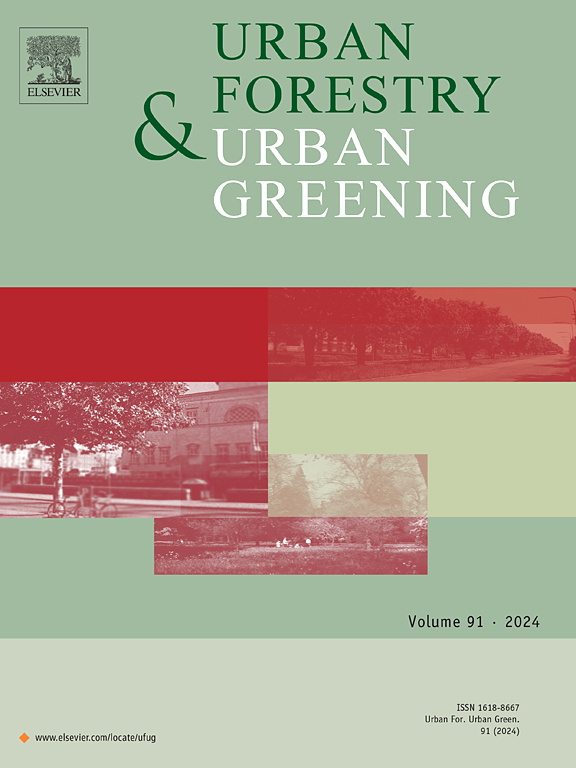Evaluation and monetisation of ecosystem services with real-time weather data and machine learning
IF 6.7
2区 环境科学与生态学
Q1 ENVIRONMENTAL STUDIES
引用次数: 0
Abstract
Urban Green Infrastructures (GI) and Nature-based Solutions (NBS) play an essential role in the adaptation of urban spaces to climate change. However, implementation has been very low so far because there are uncertainties regarding their effects and benefits. In this context, we developed a method to evaluate and monetise current ecosystem services (ESS) provided by such GI. Our approach links current weather data with the greenpass technology via machine learning. This cloud-based method was tested and applied with a case study focusing on a perimeter building in Vienna, Austria. The GI applied were trees, green roofs, façade greenings, lawn, shrubs and perennials. The ESS include impacts on urban climate, energy balance of adjacent buildings, water balance and sewer system relief, CO2 sequestration and O2 production, as well as designation of the impact on property value. For the Viennese case study, regular benefits from ESS provided by the applied GI add up to € 340,000.- per year, while a one-time increase in property value results in € 1073,600.- for the whole perimeter. Knowing the value of GI supports city administrations and large companies to predict and record the benefits and include them in the accounting. Cost-benefit considerations become easier and financial reservations or barriers for implementation of GI can be overcome.
利用实时天气数据和机器学习对生态系统服务进行评估和货币化
城市绿色基础设施(GI)和基于自然的解决方案(NBS)在城市空间适应气候变化方面发挥着重要作用。然而,到目前为止,执行情况非常低,因为它们的影响和效益存在不确定性。在此背景下,我们开发了一种方法来评估这种地理标志提供的当前生态系统服务(ESS)并将其货币化。我们的方法通过机器学习将当前天气数据与greenpass技术联系起来。这种基于云的方法在奥地利维也纳的一个周边建筑的案例研究中进行了测试和应用。GI的应用包括树木、屋顶绿化、庭院绿化、草坪、灌木和多年生植物。ESS包括对城市气候的影响、相邻建筑的能量平衡、水平衡和下水道系统的缓解、二氧化碳封存和氧气生产,以及对财产价值的影响。对于维也纳的案例研究,申请GI提供的ESS定期福利总计达34万欧元。-每年,而财产价值的一次性增长导致1073 600欧元。-整个周边。了解GI的价值有助于城市管理部门和大公司预测和记录收益,并将其纳入会计核算。成本效益考虑变得更加容易,并且可以克服地理标志实施的财务保留或障碍。
本文章由计算机程序翻译,如有差异,请以英文原文为准。
求助全文
约1分钟内获得全文
求助全文
来源期刊

Urban Forestry & Urban Greening
FORESTRY-
CiteScore
11.70
自引率
12.50%
发文量
289
审稿时长
70 days
期刊介绍:
Urban Forestry and Urban Greening is a refereed, international journal aimed at presenting high-quality research with urban and peri-urban woody and non-woody vegetation and its use, planning, design, establishment and management as its main topics. Urban Forestry and Urban Greening concentrates on all tree-dominated (as joint together in the urban forest) as well as other green resources in and around urban areas, such as woodlands, public and private urban parks and gardens, urban nature areas, street tree and square plantations, botanical gardens and cemeteries.
The journal welcomes basic and applied research papers, as well as review papers and short communications. Contributions should focus on one or more of the following aspects:
-Form and functions of urban forests and other vegetation, including aspects of urban ecology.
-Policy-making, planning and design related to urban forests and other vegetation.
-Selection and establishment of tree resources and other vegetation for urban environments.
-Management of urban forests and other vegetation.
Original contributions of a high academic standard are invited from a wide range of disciplines and fields, including forestry, biology, horticulture, arboriculture, landscape ecology, pathology, soil science, hydrology, landscape architecture, landscape planning, urban planning and design, economics, sociology, environmental psychology, public health, and education.
 求助内容:
求助内容: 应助结果提醒方式:
应助结果提醒方式:


